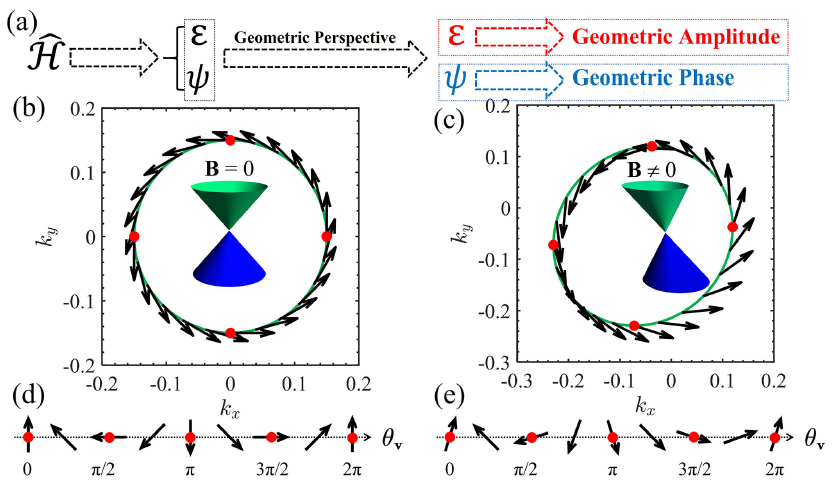On July 19, 2024, Shu-Hui Zhang published a research paper entitled “Geometric Amplitude Accompanying Local Responses: Spinor Phase Information from the Amplitudes of Spin-Polarized STM Measurements” in a distinguished physics journal Physical Review Letters.
In periodic systems described by quantum mechanics, solving the Hamiltonian of a system yields the energy dispersion and eigenstates. At initial stage of condensed matter physics, i.e., the era of solid state physics, the energy dispersion is regarded as the key to understand the properties of various crystalline materials. In 1984, M. V. Berry pointed out the gauge-invariant and observable phase effect of eigenstates, namely Berry phase. Thus, various physical phenomena were found to be dictated by the Berry phase, leading to the emergent geometric phase physics. However, the geometric properties of the energy dispersion go unheeded.
This letter provides geometric insight into energy dispersion (as shown in Fig. 1), this helps introduce a geometric amplitude named as the geometric density of states since it is locally determined by the Riemann curvature of the constant-energy contour. The geometric amplitude should accompany various local responses, which are generally formulated by the real-space Green’s function. By utilizing the geometric density of states, the real-space Green’s function can be simplified into its ultimate form with clear physics. In particular, the amplitude factor of Green’s function embodies the spinor phase information of the eigenstates, which is used to suggest the extraction of the spin texture for topological surface states through spin-polarized STM measurements, regardless of the presence of the magnetic field. This work opens a new avenue for exploring the geometric properties of electronic structures and excavates the unexplored potential of spin-polarized STM measurements to probe the spinor phase information of eigenstates from their amplitudes.

Fig. 1 (a) Geometric amplitude vs geometric phase. Geometric amplitude favors the extraction of spinor phase information of topological surface states at zero magnetic field (b, d) and at finite magnetic field (c, e).
The first communication unit of this paper is Beijing University of Chemical Technology (BUCT). For this paper, Dr. Shu-Hui Zhang is the first author, and Dr. Shu-Hui Zhang, Prof. Wen Yang of Beijing Computing Science Research Center (CSRC) and Prof. Kai Chang of Zhejiang University are the joint corresponding authors. The important collaborators include Dr. Jin Yang of CSRC, Prof. Ding-Fu Shao of Institute of Solid State Physics of CAS, and Prof. Jia-Ji Zhu of Chongqing University of Posts and Telecommunications.
Paper link:https://journals.aps.org/prl/abstract/10.1103/PhysRevLett.133.036204.
Author Introduction
Shu-Hui Zhang:He is an associate professor of the college of mathematics and physics of BUCT, and was selected into the 100 young talents program of BUCT. He has been engaged in the study of novel electronic transport in quantum materials, and published more than 30 articles in important physical journals such as PRL and PRB, and presided one youth project and one general project of the National Natural Science Foundation of China.
